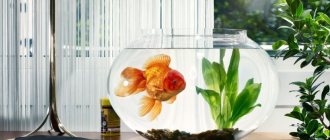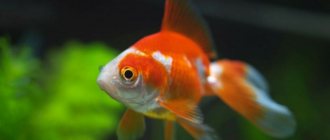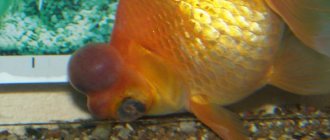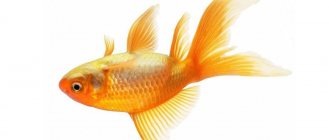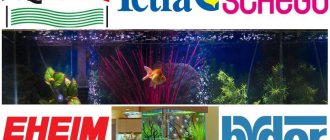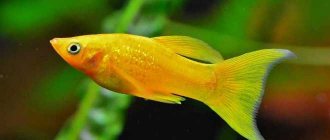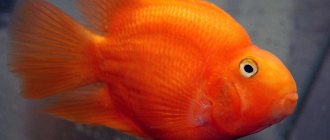Oranda “Little Red Riding Hood” is a very unusual aquarium fish that serves as a real decoration for your home pond. It is popular all over the world, but at the same time it does not have its own habitat as such: this pet is the result of long labors of Asian breeders (in China, where most of the oranda breeding experiments took place, they are called “water flower”).
The red cap is a breed of goldfish from the carp family. This variety is distinguished by an unusual head shape. Thanks to their bright red growth, these underwater inhabitants are highly valued in the East. They are especially popular in Japan, where there are special criteria for assessing the appearance, size and body proportions of aquarium inhabitants. In our country, oranda is also found quite often, it is an ideal option for goldfish lovers. Taking care of her is not too difficult.
Description
Popular for its unusual appearance, different from the usual Goldfish. The oval body, expanded on the sides, looks like an egg. They grow on average up to 15–20 cm. Of particular value is the bright red wen that covers the top of the head and ends at eye level. When breeding fish, individuals with the largest caps were selected. Until now, the fish that has a larger head with a red wen is considered more valuable. Such representatives are valued at much higher prices.
The color of all representatives is the same - the body is white-pinkish in color with metallic tints. Representatives of other colors are less common.
The fins are translucent and whitish in color. The fish have genes for the veil tail, from which the red cap got a long veil-like tail, often exceeding the length of the body. Individuals with a caudal fin in the form of a skirt are especially valued.
Types of oranda:
- Black oranda. The body color is charcoal black, with gold inclusions.
- Blue oranda. Gray or blue colors.
- Calico oranda. The main color is pale golden-red with chaotic spots of different colors.
- Chocolate oranda. Body color is brown-chocolate.
Behavior
The red cap aquarium fish is a peaceful inhabitant of the aquarium, rarely getting into skirmishes or fights with other residents. Most often, representatives treat others neutrally, not noticing other species. But it loves to swim in the company of its own kind, so it is advisable to keep it in a small flock.
Lifespan
The average lifespan of this aquarium fish is 13-16 years. One record holder lived for more than 40 years.
Popular types
This species has a large number of color shades. So, there are scarlet, gold, orange, white, brown, black fish. Here are some of the most common types of orandas:
Giroshima
It is a beautiful species, having furry growths near the mouth. At the tip of the nose it has a blue, red or white pompom.
Blue
She has a matte body sheen, with a blue spot near her back.
Gray
Silver scales, dark head, fins with rounded ends.
Calico oranda
One of the oldest subspecies. It was obtained by crossing the motley telescope and the oranda. This species requires a larger aquarium.
Black oranda
It has a pronounced growth on the head and is distinguished by a velvety dark color.
Redcaps are beautiful, fast and easy to care for fish. Even a novice aquarist can start them. Compliance with the conditions of detention prolongs their life.
Content
Goldfish have a stigma of being messy. But this is not true, they pollute the aquarium no more than other species and need infrequent cleaning 1-3 times a month. And this myth arose due to the large amount of food consumed.
Caring for the little red cap fish includes weekly replacement of 1/3 of the volume of water in the aquarium.
Aquarium
The size of the aquarium for one Goldfish is 50 liters. For a small flock of several representatives, you will need an aquarium of more than 100–150 liters. The number of decorations should be minimal. Sand and decorative items are also selected taking into account the remaining free space for swimming. Large volume is much more important than cover.
Water parameters
Comfortable temperature is 16–25 degrees. Acidity should not exceed 8 pH and be not lower than 5 pH. Water hardness 6–18 gH.
Plants
They are partial to live plants in the aquarium. Often the leaves are bitten off, and the roots are dug up and gnawed. For tanks with red caps, rigid-leaved plants with a strong root system or artificial vegetation are suitable.
Suitable plants:
- Anubias.
- Aponogeton rigidifolia.
- Congo fern.
- Microsporium or Thai fern.
- Echinodorus.
- Crinum calamistratum.
- Cyperus Helfera.
- Lagenander Meebold.
Priming
Oranda is distinguished by its love of digging. To avoid unnecessary pollution of the aquarium, choose river sand or crushed gravel or pebbles as a substrate. Avoid large stones with sharp edges.
Equipment
The aquarium is equipped with an aeration device and a filter.
Install a powerful compressor, because red caps are especially sensitive to the amount of oxygen in the water. A filter will help keep the aquarium clean and remove excess organic matter.
Lighting
Goldfish love direct sunlight and bright artificial lighting. In prolonged dim light their color fades.
Diseases
With overcrowding and low water temperature in an aquarium with orandas, ichthyophthyriosis, a disease caused by the ciliates Ichthyophthirius multifiliis, can break out. Externally, it appears in the form of whitish grains on the body and fins. At an early stage, the disease responds well to treatment. To eliminate semolina, fish are kept in salted water, iodine, furatsilin or malachite greens are added, but the most effective remedy is industrial preparations such as Antipar, Sera Omnisan, Aquarium Pharmaceuticals, Sera Costapur.
Among the non-infectious diseases of the red cap, inflammation of the gastrointestinal tract comes first. These problems can be avoided by providing the fish with high-quality and varied food, and by preventing the ingestion of small fractions of soil.
Little Red Riding Hood in an aquarium is a sea of positive emotions and aesthetic pleasure. Goldfish look spectacular in large species aquariums and do not require much effort in maintenance, so the beautiful oranda can be safely recommended even to beginners.
Feeding
Oranda red cap is unpretentious in its choice of food; it eats live, plant, dried and frozen food. But a significant part of the food should still consist of vegetation.
These aquarium fish have a high appetite. Develop a feeding plan in advance and stick to it daily. Feed fry and juveniles twice a day, reduce the diet of adults to 1 feeding per day.
If you do not adhere to the diet, then the fish will show a symptom of overeating - it begins to swim on its side. If you overeat, reduce the dose of food and arrange a fasting day.
Specialized industrial food for Goldfish also eats well.
Origin
Oranda cannot be found in natural bodies of water, since it was bred artificially by breeders from China. This variety of goldfish has been known since ancient times; the first descriptions date back to the 15th century.
Like other representatives of the genus, the oranda is a descendant of the Chinese silver crucian carp. In the East, particularly in Korea, fish with bright orange scales were revered as sacred and were often presented as gifts to Buddhist monks. The temple servants carried out a strict selection, crossing only the most extraordinary specimens, and thus marked the beginning of breeding work.
Compatibility
The red cap goldfish is a peaceful and schooling species. Therefore, it is well compatible with all representatives of Goldfish, calm or neutral species that do not pay attention to goldfish.
View this post on Instagram
Posted by Aquarium and Pet Supplies (@_kamidog_) Feb 21, 2018 at 4:39 am PST
Compatible Types:
- Danio Rerio.
- Shubunkin.
- Guppy.
- Telescope.
- Comet.
- All types of catfish.
- Ternetia.
- Cardinal.
Low compatibility with large and territorial fish that show aggression. I still can’t stand being in the vicinity of nimble and active fish, which will bully calm red caps and spoil and tear off long fins. Too miniature species are also not suitable - they will be quickly eaten.
Incompatible types:
- Barbus.
- Discus.
- Sword bearer.
- Cockerels.
- Neons.
- Mollies.
- Fry of small fish species.
Nutrition
In stores you can find food designed specifically for this type of fish.
Oranda prefers food of both plant and animal origin. The fish is voracious and requires three meals a day in small portions. The diet consists of large bloodworms, tubifex, brine shrimp, daphnia, scalded cabbage, spinach and lettuce, buckwheat and oatmeal. You can also keep oranda on industrial food, developed taking into account all the characteristics of the species.
Reproduction
Representatives become sexually mature and capable of reproduction at 1.5–2 years of age. For procreation, a female and 2–4 males are selected. If you want to get valuable and expensive fry, then choose from the flock representatives with the largest caps and long tails. If the fry are not for sale and will remain in the aquarium, then any representatives are suitable.
Set up a separate spawning area and move selected individuals into it.
Differences between a female and a male
Sexual dimorphism is weak; sex determination is difficult. Typically, males are smaller in size, and their bodies are more graceful and elongated. Females are larger and more massive. Before spawning, the color of males becomes brighter and white spots appear on the head.
Spawning
Food portions increase before spawning, and a variety of foods are introduced into the diet. To stimulate the spawning tank, lower the temperature by a couple of degrees.
Most often, the female begins to spawn in the morning at dusk. The spawning process lasts 2–4 hours. The eggs are laid on the leaves of planted plants. After spawning, the parents are placed in a common aquarium because they are able to eat the eggs.
Breeding
To breed offspring, an aquarist needs a special aquarium of 50-100 liters - a spawning tank. The water in it should be 4-6 °C lower than usual. A sand hill is made at the bottom, a special net for eggs is installed, and thick algae with soft leaves are planted.
For successful reproduction of healthy individuals from 18 months and older, they need to be fed live food for a long time, which is often replaced with pieces of meat. During this period, usually in the spring, the female’s belly swells with eggs, and the gills of the males become covered with small bubbles. The day before transplanting two males and a female into a separate container, the fish are not fed.
After spawning, which lasts 4-5 hours, the fish are transplanted back, and cloudy, lifeless eggs are removed from the spawning tank and part of the water is drained. After 3-4 days, the fry appear and are fed live dust.
Reviews
The opinions of aquarists who bought red cap aquarium fish vary. Although initially the beauty and calm disposition win the hearts of buyers, later problems arise in caring for the red cap fish. Novice aquarists who have overestimated their strengths complain about the difficulties of keeping a pet. The main reason for difficult care is the large amount of released organic matter. And if the aquarium is not properly cleaned, mold, brown algae appear, and the water becomes cloudy.
Goldfish Comet
Comet fish is a breeding form of goldfish. It was developed in the USA in 1800. These aquarium inhabitants are representatives of the genus Karas, so they are characterized by a rather simple body structure. And belonging to the elite of the fish kingdom is evidenced by a truly luxurious tail - long, with a fork and a deep neckline.
Comet
The character of the fish is very calm and peaceful. They get along well with all representatives of the Goldfish class, as well as with tetras, aquarium catfish, and viviparous fish.
Aquarium water for keeping Comet must have the following characteristics:
- temperature: 20-23 degrees, although individuals feel quite normal at lower temperatures (up to 15 degrees);
- hardness - 6-18 F;
- pH - 5-8.
Some of the water should be changed regularly. The volume of the aquarium depends on the number of inhabitants. On average, one representative of Goldfish should have at least 40 liters of water. For two fish, 70 liters is quite enough, that is: the more inhabitants in the aquarium, the greater their density is allowed. But in this case it is necessary to ensure high-quality aeration.
You should not expect that order will be maintained in the aquarium where the Comet goldfish and its companions live. Despite their inactivity, Comets love to rummage in the ground (like all other representatives of the Carp). Therefore, the aquarium should have coarse sand or pebbles without sharp particles in a layer of 5-6 cm. For the same reason, you should not plant too fastidious plants that will be eaten or dug up in the shortest possible time. The most durable plants are those with a strong root system and hard leaves, for example, Vallisneria, egg capsule or elodea.
This variety of Goldfish is completely unpretentious in its choice of food. They happily eat any type of live and plant food. However, such indiscriminate eating often leads to their obesity. If the red fish is “swollen” on its sides or stomach, then once a week it should be given a fasting day, in a neglected form - even put on a starvation diet for several days. To prevent obesity, you should feed your fish daily only 3% of food in relation to their body weight.
Also, the Comet fish needs bright lighting. It allows you to highlight and enhance its beautiful color. You can determine that the conditions for keeping fish are unsuitable by the following signs:
- The fins or tail are separated - excessive density of fish population.
- The fins or the entire body have turned black - the composition of the water is unsuitable.
Normal maintenance of Comets in an aquarium is impossible without a heater and a powerful filter. Living conditions have a great influence on the appearance of fish, as well as their ability to breed.
Reproduction
Comet fish are usually ready to breed when they reach 2 years of age. Spawning usually occurs in the first spring months. Readiness for reproduction can be determined by the following signs:
- in males: on the gill covers there are warts, on the front pair of fins there are serrations;
- in females, the belly becomes dense, tightly stuffed with eggs.
The Comet fish reproduces best in a well-equipped spawning area:
- The volume of the aquarium is 25-30 liters of soft fresh water.
- The temperature is 5-8 degrees higher than standard, that is, about 25-30 degrees.
- The aquarium must be filled with sandy soil and small-leaved plants, and a protective net is installed at the bottom to protect the eggs from being eaten.
Before spawning, it is better to separate males from females for several weeks. At this time, their diet should be as nutritious and varied as possible. Before breeding, you can arrange a fasting day. Spawning is schooling. The males chase the females throughout the aquarium, so the eggs are placed throughout the spawning area. One female lays about 10,000 eggs. Warm aquarium water promotes the rapid hatching of fry - they appear on the second to fifth day. Their development occurs without adults, which should be immediately removed from the spawning area. At first, it is better to feed the fry with “live dust”, and a little later with rotifers and brine shrimp.
aquarists.ru>
Price
The cost depends on their age and size. The value increases depending on the size of the red wen on the head and the length of the caudal fin.
| Size, cm | Cost, rubles |
| Fry, 1–2 | 100 |
| Grown-up fry, 2–5 | 200 |
| Teens, 6–8 | 250 |
| Adults, 9–15 | 350 |
| Large representatives, 15–20 | 400–500 |
Male guppy
0
A huge number of guppies are bred in aquariums, differing in color, shape of fins and tail. The starting material was taken from various natural reservoirs. As a rule, therefore, it is almost impossible to systematize them. There are many variations of the tail fin: round tail fin, two swords, top and bottom, one sword, radish, lyre. The upper fin can be a scarf, even descending to the caudal fin. Monochrome colors are spectacular: completely black - black prince, red - albino red, green-malachite - Moscow malachite, blue - Moscow blue. Beautiful marbled guppies have tails painted black and white or black and yellow with small spots. In different countries there are a huge number of associations of guppy lovers who are passionate about the selection of these wonderful fish. The largest is the International Guppy Breeding Council, which unites 12 Western European countries. He has developed the most detailed selection standards and annually holds international competitions and exhibitions.
Photo gallery
Previous
Fish4 stages of reproduction of female and male bettas
Next
FishContent of the cocky minor (serpas)
Swordtails
Swordtails belong to the family of viviparous toothed carps. The body is elongated, flattened laterally.
The natural background color of males is light brownish-olive, with a green tint on the back. A two-millimeter red stripe runs along the sides, and below and above it there are two more narrow red stripes. The long lower ray of the caudal fin (sword) has a clear black edge. The color of the female is much paler, the body has a silvery sheen, the middle of the body is occupied by a wide stripe, and below and above this stripe there are two more narrow stripes 0.5 mm wide.
The male's body (without the sword) can grow up to 8 cm, and the female's body up to 12 cm.
Swordtails live up to three to five years.
Sword bearers VIDEO
Selection
In nature, crucian carp spawning begins in April or May. Aquarium goldens breed several times a year, starting at 1–2 years of age. If necessary, the process is stimulated by replacing more than a third of the water or raising the temperature.
Readiness for reproduction is determined by the increase in the abdomen in females. Fertilization occurs through characteristic contact between the fish's anal openings.
14:02
Launched goldfish into the spawning area
To start a 40-liter spawning tank, they purchase a lamp and an aerator, and plant the container with dense vegetation so that the parents do not feast on the laid eggs. The larvae, which form on the third day, hang upside down between the algae leaves. After 3–5 days (depending on the water temperature), the fry appear, rush upward and swallow air to be able to swim in a horizontal position.
If you replenish the aquarium with fish with characteristics you like over the course of several years, you can consolidate the species characteristics and even improve the breed.
Goldens are literally pets!
Golden ones attract owners not only with their appearance, but also with their behavior. Pets become attached to their owners, take food from their hands, and swim onto a palm placed in the water, which is especially popular with children.
Cardinal in nature
The historical homeland of these cyprinids is considered to be fast-flowing mountain streams located in southeast China.
From there the cardinal was brought to Canada (1935), then came to the USA, and after that to Europe, or more precisely to Germany (1938).
It should be noted that from 1980 to the present, cardinals are considered an extinct species in China. This is due to human influence on wildlife: mass catching of fish for aquarium keeping, pollution and drainage of water bodies. A small number of fish have survived in the provinces of Gaung Dong (China) and Quang Ninh (Vietnam), but it is negligible. The Chinese government is taking measures to preserve and restore the population.
All fish that are sold and that we see in pet stores are bred in captivity.
Major diseases
If this fish is not sick, then it has shiny scales, a bright color and high mobility. And this is not to mention the wonderful appetite. If there are deposits on the body that look like lumps of cotton wool, the fins stick together, the fish begins to swim in jerks, rubs against objects, breathing is impaired or the fins turn red - this means that this is a deviation from the norm and requires immediate treatment.
In this case, special mixtures have been developed for goldfish, but in addition to this, they need to be fed with live and plant food. If fish care is poor, then disease is inevitable. But this rarely happens to caring owners. The most important thing is to remember that such a beauty as “Little Red Riding Hood” requires a lot of attention and care.
The oranda received its nickname due to the red growth on its head, which in fact resembles an impressive headdress in its outline. They say that the red cap, as a breeding form of goldfish, was bred in the East back in the 15th century. According to some sources, its homeland is China, according to others - Japan. Both countries have been breeding goldfish for a long time.
Since the oranda is of eastern origin, the standards by which its beauty is judged also have eastern roots.
The red cap has an egg-shaped short body, veil-shaped elongated fins and a growth on the head that covers almost its entire surface. It is believed that the larger this formation is red in color with a granular structure, the more beautiful and valuable the oranda is. Another decoration of the red riding hood is its translucent fins. If you do not take into account the larger head, the appearance of the red cap resembles a veiltail.
The red cap oranda is a large fish; adults can range from 16 cm to 24 cm in length. The length and width of the body of a typical red cap should have a ratio of 10:7.
The oranda differs from other helmet-shaped varieties of goldfish by the presence of a dorsal fin. This is the only unpaired fin of the fish.
The standards stipulate that the length of the flowing caudal fin must be equal to at least 70% of the fish's body. The tail of the red cap can be shaped like a “skirt”, which makes it even more similar to the veil tail. Such specimens are valued as elite. On the contrary, fish with a fork-shaped tail are discarded.
Varieties of red riding hood are distinguished by a variety of colors. There are gold, red and chocolate orandas, calico and black. In the latter, the color of the cap does not differ from the color of the body. But the fish with a pure white body and fins are rightfully considered the most beautiful and attractive. Against their background, a bright red cap looks especially elegant.
A fairly large red cap needs a spacious aquarium, otherwise the fish may have health problems. A “reservoir” with a volume of at least 50 liters is required for one individual. But with an increase in the number of fish, the population density can be increased slightly - that is, in a 200-liter aquarium you can put not 4 fish, but 5 - 6.
In our climate, the red cap can be placed in an artificial pond only for the summer. Due to its clumsiness, the oranda can become an easy prey for cats, so measures to ensure its safety must be taken care of in advance. The very first cold snap should be the reason for its relocation to a home aquarium - the fish is very sensitive to decreases and increases in temperature.
The optimal temperature range at which the oranda will not get sick and will not lose the color of its cap is from 18°C to 24°C. Water should have acidity from 6.0 to 8.0 pH, hardness from 12 to 16°. A small amount of salt (5 - 6 grams per 1 liter of water) can improve the well-being of the little red riding hood.
It is better to give preference to a long rather than a high aquarium, in which the process of oxygen absorption occurs much faster. Oranda is sensitive to a lack of oxygen, so an aerator in the aquarium is extremely necessary. A powerful filter is also necessary - the voracious beauty heavily pollutes the water and loves to dig in the sand, raising turbidity from the bottom. The system should provide water filtration at a rate of 3 volumes per hour. In addition, once a week (more often if the water quality is unsatisfactory), a third of the volume of water must be changed to fresh.
What is the best way to populate an aquarium?
Story
Three goldfish from the painting “ Fishes Swimming Among Falling Flowers”
, paintings by Liu Cai during the Song Dynasty (c. 1080–1120)
A Western aquarium from the 1850s that included goldfish among other cold-water species.
Goldfish Ryukin, plate XIX in the book “Goldfish and Their Culture in Japan”
by Shinnosuke Matsubara
Various species of carp (known collectively as Asian carp) have been bred and raised as food fish for thousands of years in East Asia. Some of these typically gray or silver species tend to cause red, orange, or yellow color mutations; It was first recorded in Imperial China during the Jin Dynasty (266–420).
During the Tang Dynasty (618–907 AD), it was popular to raise carp in ornamental ponds and water gardens. A natural genetic mutation resulted in a gold (actually yellowish-orange) coloration rather than silver. People began selectively breeding the golden variety instead of the silver variety, keeping them in ponds or other bodies of water. On special occasions when guests were expected, they were moved to a much smaller container for display.
During the Song Dynasty (960–1279 CE), selective domestic goldfish breeding was firmly established. In 1162, the Empress of the Song Dynasty ordered the construction of a pond to collect red and gold varieties. By this time, people who did not belong to the imperial family were prohibited from keeping goldfish of the golden (yellow) variety, moreover. This is probably the reason why there are more orange goldfish than yellow ones, even though the latter are genetically easier to breed. The appearance of other colors (except red and gold) was first recorded in 1276.
During the Ming Dynasty (1368–1644), goldfish also began to be raised indoors, allowing mutations that could not survive in ponds to be selected for. The fancy-tailed goldfish was first recorded during the Ming Dynasty. In 1603, goldfish were introduced to Japan. In 1611, the goldfish was introduced to Portugal and from there to other parts of Europe.
In the 1620s, goldfish were highly prized in southern Europe for their metallic scales and symbolized good fortune and fortune. It has become a tradition for married men to give their wives a goldfish on their first anniversary as a symbol of prosperous years to come. This tradition quickly died as goldfish became more accessible and lost their status. Goldfish were first introduced to North America around 1850 and quickly became popular in the United States.
Care of offspring
Spawning usually begins in the morning and lasts several hours. When it ends, the fish are returned to their original aquarium, and the water in the spawning tank is reduced. Caviar can be transferred to smaller containers. Whitish and cloudy unfertilized eggs should be disposed of immediately, as they pollute the water. Snails can also cope with this task perfectly.
The caviar should be well lit, but it should not be overheated. Containers should not be placed in direct sunlight. The fry hatch in 3-4 days. They are given live dust as food. As they grow, young specimens are separated by size into different aquariums, otherwise the larger specimens will eat the smaller ones.
Aquarium decoration
A red cap aquarium needs bright lighting to keep the fish in healthy shape and to maximize the beauty of its color. It is better to use rounded, light-colored soil - coarse river sand or fine gravel.
Oranda is a delicate fish and also clumsy, and therefore can easily injure its veil-shaped fins on the sharp edges of stones, snags, grottoes or other “structures.” It is better not to use such items to decorate an aquarium with a red cap. The oranda desperately needs space for freedom of movement, so it is better to avoid cluttering its “personal space” altogether. Large rounded stones and vegetation will help make the aquarium landscape more interesting.
Plants for decoration – delicate foliage quickly loses its appearance in an oranda aquarium. To prevent fish digging in the ground from undermining the roots of plants, they must be planted in pots or pressed down with stones (necessarily with rounded edges). Vallisneria, sagittaria, and elodea are suitable as “green decor” for the red cap.
the best unpretentious plants.
The red cap is essentially an omnivore - it happily eats both plant and live or artificial food. But, since her body needs more carbohydrates than proteins, preference should be given to special foods. In addition, they contain natural impurities to maintain and improve bright colors in color - red, yellow, orange.
Oranda, like other goldfish, is famous for its gluttony. Therefore, the main rule that must be followed with the little red riding hood is “don’t overfeed.” It is enough to feed adult fish once or twice a day. In the case of dry food, this needs to be done more often, but just a little bit at a time - so that the food is eaten immediately and without residue. The daily volume of food should not exceed 3% of the total weight of the fish.
A sign that a red cap is overeating can be when it floats on its side after eating. Such an oranda, or a fish with signs of obesity, is advised to go on a diet or even a short daily fast.
To prevent the red cap from “encroaching” on the soft greenery in the design of the aquarium, you should enrich its diet with a sufficient amount of greenery. Both riccia and finely chopped spinach or lettuce will do.


